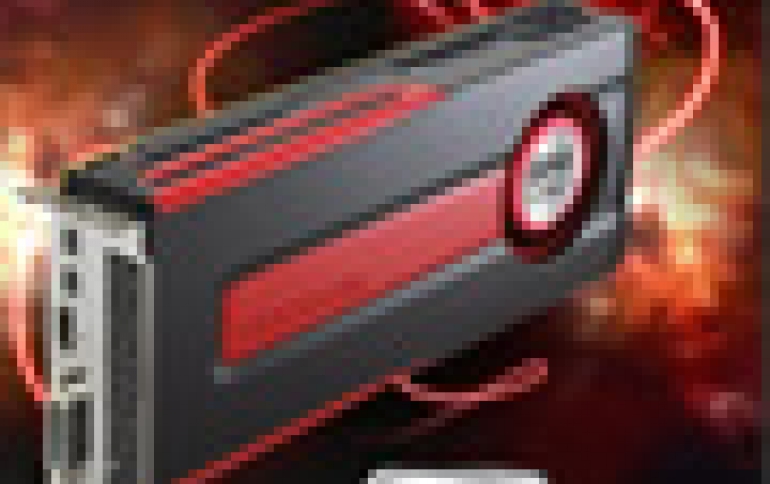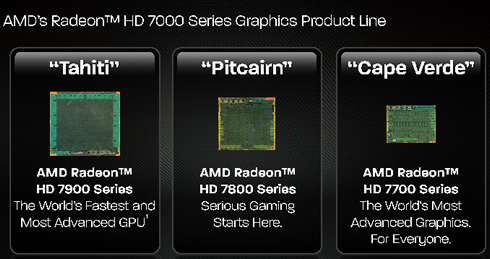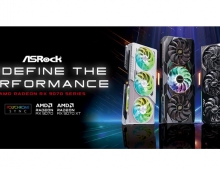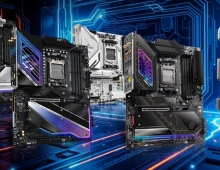
AMD Completes Radeon HD 7800 Series With New HD 7870 and HD 7850 Models
AMD today announced two new additions to its 28nm GPU
line up, the AMD Radeon HD 7870 GHz Edition and AMD
Radeon HD 7850 graphics cards.
AMD is taking the wraps off the final piece of the Southern Islands puzzle: Pitcairn. The middle version of the family, it will be the basis of AMD's $250+ enthusiast segment Radeon HD 7800 series.

Compared to the Cape Verde (7700) GPU, Pitcairn has twice the number of CUs, twice the number of ROPs, twice the memory bandwidth, and twice as many geometry engines on the frontend. This works out to 1280 SPs among 20 CUs, 80 texture units, 32 ROPs, 512KB L2 cache, and a 256-bit memory bus. Compared to Tahiti, Pitcairn still has 12 fewer CUs and as a result less shader and texturing performance along with the narrower memory bus.

Pitcairn supports DX10+ SSAA, PowerTune, Fast HDMI support, partially resident textures, D3D 11.1 support, and the still-AWOL Video Codec Engine (VCE). FP64 support is once again present, and like Cape Verde it's a performance-limited implementation for compatibility and software development purposes, with FP64 performance limited to 1/16th FP32 performance.
The 7870 is a full Pitcairn, clocked at 1000MHz core and paired with 2GB of GDDR5 running at 4.8GHz. It has a PowerTune limit of 190W while AMD puts its typical board power draw closer to 175, meanwhile idle power consumption is around 10W with a long idle of 3W. As for the 7850 it?s the typical lower tier part, featuring 16 active CUs (1024 SPs), an 860MHz core clock, and the same 2GB of GDDR5 running at 4.8GHz as its counterpart, giving it 68% the shading/texturing performance and 86% of the ROP & frontend performance of the 7870. The PowerTune limit is 150W with a typical board power of 130W, and the same 10W/3W idle power consumption as the 7870.

For display connectivity AMD is using the same configuration as we've seen on the 7900 series: 1 DL-DVI port, 1 HDMI port, and 2 miniDP ports. The 7800 series can drive up to 6 monitors but only 2 TMDS type displays at once, and if you want to drive a full 6 monitors you'll need a MST hub.
The AMD Radeon HD 7800 series also comes equipped with PCI Express 3.0 and the AMD ZeroCore Power technology. The AMD Radeon HD 7800 Series also provide gamers tools like AMD PowerTune, AMD Eyefinity 2.0 and AMD CrossFire technologies.
Both cards will be available worldwide from AMD's add-in-board partners like ASUS, Club 3D, Diamond, Gigabyte, HIS, MSI, Powercolor, Sapphire, VisionTek and XFX via retailers and e-tailers.
The 7870 will have an MSRP of $350, while the 7850 will have an MSRP of $250.
AMD is taking the wraps off the final piece of the Southern Islands puzzle: Pitcairn. The middle version of the family, it will be the basis of AMD's $250+ enthusiast segment Radeon HD 7800 series.

Compared to the Cape Verde (7700) GPU, Pitcairn has twice the number of CUs, twice the number of ROPs, twice the memory bandwidth, and twice as many geometry engines on the frontend. This works out to 1280 SPs among 20 CUs, 80 texture units, 32 ROPs, 512KB L2 cache, and a 256-bit memory bus. Compared to Tahiti, Pitcairn still has 12 fewer CUs and as a result less shader and texturing performance along with the narrower memory bus.

Pitcairn supports DX10+ SSAA, PowerTune, Fast HDMI support, partially resident textures, D3D 11.1 support, and the still-AWOL Video Codec Engine (VCE). FP64 support is once again present, and like Cape Verde it's a performance-limited implementation for compatibility and software development purposes, with FP64 performance limited to 1/16th FP32 performance.
The 7870 is a full Pitcairn, clocked at 1000MHz core and paired with 2GB of GDDR5 running at 4.8GHz. It has a PowerTune limit of 190W while AMD puts its typical board power draw closer to 175, meanwhile idle power consumption is around 10W with a long idle of 3W. As for the 7850 it?s the typical lower tier part, featuring 16 active CUs (1024 SPs), an 860MHz core clock, and the same 2GB of GDDR5 running at 4.8GHz as its counterpart, giving it 68% the shading/texturing performance and 86% of the ROP & frontend performance of the 7870. The PowerTune limit is 150W with a typical board power of 130W, and the same 10W/3W idle power consumption as the 7870.
| AMD GPU Specification | |||||||
| AMD Radeon HD 7870 |
AMD Radeon HD 7850 |
AMD Radeon HD 6970 |
AMD Radeon HD 6950 |
AMD Radeon HD 5870 |
|||
| Stream Processors | 1280 | 1024 | 1536 | 1408 | 1600 | ||
| Texture Units | 80 | 64 | 96 | 88 | 80 | ||
| ROPs | 32 | 32 | 32 | 32 | 32 | ||
| Core Clock | 1000MHz | 860MHz | 880MHz | 800MHz | 850MHz | ||
| Memory Clock | 4.8GHz GDDR5 | 4.8GHz GDDR5 | 5.5GHz GDDR5 | 5.0GHz GDDR5 | 4.8GHz GDDR5 | ||
| Memory Bus Width | 256-bit | 256-bit | 256-bit | 256-bit | 256-bit | ||
| Frame Buffer | 2GB | 2GB | 2GB | 2GB | 1GB | ||
| FP64 | 1/16 | 1/16 | 1/4 | 1/4 | 1/5 | ||
| Transistor Count | 2.8B | 2.8B | 2.64B | 2.64B | 2.15B | ||
| Manufacturing Process | TSMC 28nm | TSMC 28nm | TSMC 40nm | TSMC 40nm | TSMC 40nm | ||
| Architecture | GCN | GCN | VLIW4 | VLIW4 | VLIW5 | ||
| Price Point | $350 | $250 | N/A | N/A | N/A | ||

For display connectivity AMD is using the same configuration as we've seen on the 7900 series: 1 DL-DVI port, 1 HDMI port, and 2 miniDP ports. The 7800 series can drive up to 6 monitors but only 2 TMDS type displays at once, and if you want to drive a full 6 monitors you'll need a MST hub.
The AMD Radeon HD 7800 series also comes equipped with PCI Express 3.0 and the AMD ZeroCore Power technology. The AMD Radeon HD 7800 Series also provide gamers tools like AMD PowerTune, AMD Eyefinity 2.0 and AMD CrossFire technologies.
Both cards will be available worldwide from AMD's add-in-board partners like ASUS, Club 3D, Diamond, Gigabyte, HIS, MSI, Powercolor, Sapphire, VisionTek and XFX via retailers and e-tailers.
The 7870 will have an MSRP of $350, while the 7850 will have an MSRP of $250.





















